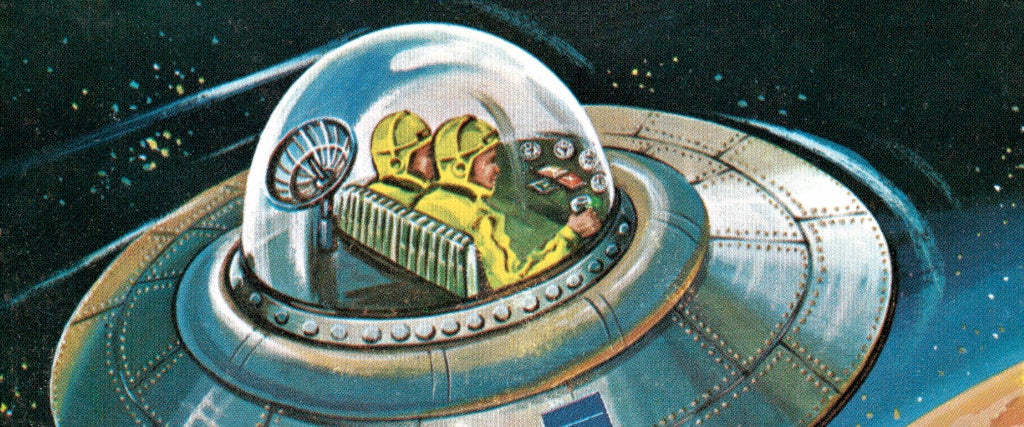Who, perusing a rack of science-fiction paperbacks in the 1970s, could resist the come-on?: “Eight fascinating studies of life in the year 2020.” If the premise wasn’t intriguing enough, the names should have sealed the deal. These tales of the distant future would be coming from writers like Harlan Ellison, Larry Niven and Ben Bova. If they couldn’t offer hints about what lay ahead, who could?
Published by Avon in 1974 (and reprinted in an anniversary edition earlier this year), 2020 Vision looked (almost) 50 years into the future to imagine the world in which we now live. That world doesn’t much resemble the world found within its pages — but that doesn’t mean the writers got it all wrong.
Some stories get a few details absolutely right. In “Prognosis: Terminal” — written by David McDaniel, one of the collection’s more obscure authors — Los Angelenos travel by pedway, live under domes and stand in line for “free artificial food,” but they also communicate via pocket phones in a world in which actors and other artists have to compete with “part-time amateurs who work for nothing.” “Everything on the screens is done by a couple thousand people, with a million more talented hopefuls trying to cut themselves in,” a character complains. What’s more, a flip of a switch can change any user’s image. McDaniel, who died in 1977, didn’t live long enough to use Snapchat or TikTok, but he saw them coming.
As a book of technological, political and sociological predictions, however, it’s mostly a dud. Poul Anderson’s “The Pugilist” concerns the undercover adventures of John Reed, an American colonel planning to participate in a coup against the Soviet-controlled People’s Republic of the United States and prevent a war with China. Before he can act, however, he’s taken prisoner by the government and forced to work as a triple agent thanks to a remarkable bit of leverage: They’ve cut off his penis and promised to return it to him only when the job is done. “I believe the removed part is still in the alcohol in the laboratory,” his captor tells him. “Would you like to see it?” (Reed declines.)
Emasculation was on other writers’ minds as well. “Future Perfect,” written by A.E. van Vogt, imagines a 2020 in which all 18-year-old men are given a million dollars on their birthday with two conditions: 1) that’s all they get and 2) they must agree to marry a compatible woman five years their senior (the age of maximum compatibility, per government calculations) if they want to receive an injection that will “unlock” their sex organs. It just makes sense, since, as one psychiatrist argues, “when biology solved the problem of locking up the male sex organ, and later opening it up so that it could function only with one woman — his wife — the entire course of family relations and in fact human history was altered in a positive fashion.”
Van Vogt’s rebellious protagonist naturally disagrees. And while not much unites the worlds envisioned by the contributors, they all share a general lack of optimism about things to come. Each, however, follows their own path to pessimism. In Norman Spinrad’s “A Thing of Beauty,” the once-great United States of America is being sold for parts to wealthy Japanese clients interested in acquiring its landmarks as nostalgic reminders of its past. The 1980s would be filled with visions of ruthless Japanese businessmen, but in Spinrad’s story, America’s greed is responsible for its downfall — and the resulting fire sale on such items as the Statue of Liberty, Yankee Stadium and the U.N. building. (The item the story’s protagonist ultimately sells to the gracious Mr. Ito gives the story an almost wistful punchline.)
Dian Girard, the sole female contributor, can only imagine life has gotten worse for women in her 2020. Cheryl, the protagonist of “Eat, Drink, and Be Merry,” lives a regulated life of mandatory weigh-ins and carefully regulated meals that keep her at a computer-determined ideal weight. Her “fleeting, satisfying, heart-warming visions of divorce” prove as unattainable as her desire for fried chicken and candy. That Girard saw the era’s feminist advancements ultimately going nowhere might seem short-sighted, but only if you skip collection editor Jerry Pournelle’s introduction to the story, which reads, “Dian Girard is a lovely young brunette who doesn’t seem to suffer the tortures of the damned to keep her figure. If she does, secretly, then believe me it’s worth what she has to pay. To us onlookers, anyway.”
For others, the upheavals of the 1960s and 1970s form the core of their stories. Larry Niven’s “Cloak of Anarchy” takes place in one of 2020 L.A.’s Free Parks, places where anything goes so long as expressions of freedom never turn to violence. Keeping the peace are “copseyes,” cameras equipped with stunners to keep revelers in line. Projecting the hippie counter-culture around him into the 21st century, Niven uses the story to toss around some musings about anarchy and its limitations that start to veer into libertarianism. “What does a government do for anyone except the people who run the government?” one character asks. “Once there were private post offices, and they were cheaper than what we’ve got now. Anything the government takes over gets more expensive, immediately.” His thoughts are then interrupted by a naked woman slapping a man in a bird costume.
2020 is going to be wild, can you dig it?
Ben Bova’s “Build Me a Mountain” features frequent Bova protagonist Chet Kinsman navigating a room full of politicians and grumpily making a case for a permanent moonbase. He sees it as a chance for humanity to start over. His ex-flame Diane, a dark-eyed protest singer, sees things differently:
Diane said, “Chet, haven’t you learned anything? We’re in two entirely different worlds. You want to go adventuring.”
“And you want to join demonstrations and sing to the kids about how lousy the world is.” “I’m trying to make the world better!” Her face looked so damned intent.
“And I’m trying to start a new world.”
She shook her head. “We never did see eye to eye on anything.”
“Except in bed.”
But can great sex be enough to patch over political differences? Even in Niven’s 2020 the answer seems to be “no.”
Neither Pournelle nor most of his contributors were shy about politics. Often described as a “paleoconservative,” Pournelle signed his name to a statement supporting the Vietnam War that ran in Galaxy magazine in 1968, opposite a list of science-fiction writers opposed to the war. So did Niven who, like Pouornelle, served as an advisor on Ronald Reagan’s Strategic Defense Initiative. Politically they had little in common with Harlan Ellison, which Pournelle acknowledges while introducing Ellison’s “Silent in Gehenna,” writing, “Harlan says I’m a fascist imperialist pig; and if a fascist imperialist pig can see a grim moral in a Harlan Ellison story, that’s scary.”
That grim moral arrives via the story of Joe Bob Hickey, a born rebel with a fondness for blowing up buildings who finds his calls to arms falling on increasingly deaf ears: “He tried to speak to them about what was happening in America, about the inviolability of the Pentagon Trust, about the abolishment of the Supreme Court, about the way colleges trained only for the corporations or the Trust, about the central computer banks in Denver where everyone’s identity and history were coded for instant arrest, if necessary. About all of it. But they knew that. They didn’t think it was bad. They thought it kept the saboteurs in their place so the country could be as good as it had always been.”
Ellison’s story ends on a grim twist with which the author felt a personal connection, as he reflected on it in a 1998 interview with The Onion’s A.V. Club: “Suddenly there’s this golden glow, and he’s captured by a machine that brings people to the future, and he finds himself in this golden cage suspended over a street, and coming down the street are these great grotesque alien creatures, Jabba The Hutt kind of things, on palanquins dragged by yoked teams of human beings. This guy, being a revolutionary, stands up there and screams at them, ‘Throw off your chains! Fight for your humanity! This is evil, evil! They mustn’t use others as slaves!’ They stop beneath them and beat their breasts and say, ‘God, yes, this is evil, evil. It’s not a good thing.’ But then they roll on past and forget the whole thing. And he realizes, as all revolutionaries do, that you’re just a fucking clown shouting at people who are agreeing, but not really listening.
Maybe that sense of futility is just the fate of all those who try to use the future to warn against the problems of the present. And maybe that’s why even visions of the future that don’t pan out on the literal level have a different sort of value. Reading 2020 Vision in 2020, it’s striking how much its creators’ ideas have their roots in the early 1970s. It’s humbling, too, to realize how hard it is even for those who look to the future professionally to see beyond the near horizon.
Near the end of his intro, Pournelle writes, “We will, many of us writers and readers, be around in 2020, medical science being what it is — assuming that anyone will be around in 2020.” He then promises to buy readers a drink at the 2020 World Science Fiction Convention, provided they show up with a copy of the book and some observations about what it got wrong.
Pournelle died in 2017 and, of 2020 Vision’s contributors, only three (Niven, Anderson and Spinrad) remain alive. And though some events took place virtually, Worldcon 2020, scheduled to be held in New Zealand, was forced to cancel due to the coronavirus pandemic no one saw coming. But the timelessness of the collection’s central concerns — about freedom, waste, decline and creeping complacency — remain just as striking as the book’s 1970s-ness. Its best moments read like warnings from the past about the present that still have relevance to the future.
It may be a fool’s game, imagining tomorrow, but that doesn’t mean there’s nothing to be learned from trying.

